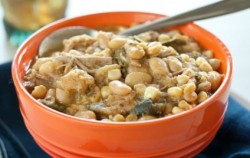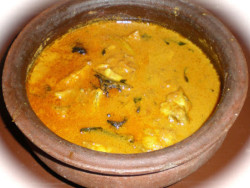After a seemingly never-ending heat wave in San Diego, we have a day of rain and a slight chill in the air. It feels like autumn! This puts me in the mood for warm, stew type dishes. One of my favorite ways to make stews, both for it’s convenience and intricate flavor, is with a crock pot. By taking a few minutes to add the ingredients in the morning and letting the meal slow-cook throughout the day, I can enjoy the day (or leave the crock while I go to work) and come home to a meal that tastes delicious, not to mention like I have spent hours working to perfect the combination of spices. Win-win-win: time saver, tasty food and healthful! Using the crock pot is also a perfect way to impress guests when entertaining because the meal is sumptuous yet you don’t need to spend the whole time in the kitchen.
This recipe for Slow Cooker White Chili is turn-of-autumn nourishment. The cauliflower thickens and adds, instead of calories, additional nutrition. Spiciness is balanced well with the tartness of the lebne. Add a touch of lemon juice and it’s perfection.
Slow Cooker White Bean Chili
Ingredients:
2 chicken breasts and 4 chicken thighs, skinless
1 bad dried cannellini beans
2 poblano peppers (or green bell peppers), chopped
1 head cauliflower, trimmed and cut into small florets
1 yellow onion, chopped
2 quarts low-sodium chicken (or vegetable) broth
1-1/2 Tablespoons(T) ground cumin
1 T chili powder
3/4 cup lebne (or Greek yogurt)
2 teaspoons sea salt
lemon wedges, for garnishing
Method:
Arrange chicken in bottom of a 6-quart slow cooker. Top with beans, peppers, onion, broth, cumin and chili powder. Cover and cook on low until bean are very tender and cauliflower falls apart, about 10 hours. To serve, ladle into bowls and top with yogurt, sea salt and a squeeze of lemon. Serves 8-10.


